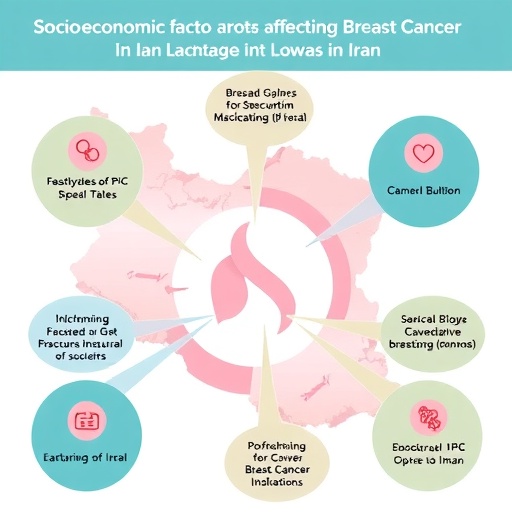In a groundbreaking study released in 2025, researchers from Iran have unveiled critical insights regarding how socioeconomic disparities significantly influence breast cancer care and survival rates within the country. The research, published in the esteemed journal Scientific Reports, examines the multifaceted impact of economic status, education level, and access to healthcare services, shedding light on a deeply concerning issue that affects communities across Iran. With breast cancer emerging as a leading health concern, understanding the associated socioeconomic risks is more crucial than ever in developing robust intervention strategies.
The study is underpinned by the recognition that breast cancer is the most prevalent type of cancer among women in Iran. Over the years, the incidence of this disease has soared, creating an urgent need to address the factors contributing to both its rise and its differential impact among various socioeconomic groups. The researchers operationalized the correlation between economic disparity and healthcare outcomes, employing comprehensive data analysis that draws from clinic-based records and demographic information.
At the core of their investigation lies the stark reality of access to healthcare. For many women in lower socioeconomic brackets, barriers to receiving timely and effective treatment can be monumental. These obstacles are often exacerbated by a lack of awareness about breast cancer symptoms and the importance of early detection. The research highlighted that women from affluent backgrounds benefit from superior education regarding their health, leading to earlier diagnoses and, consequently, better survival rates.
Interestingly, the study also touched upon the geographical disparity within Iran. Women living in rural or remote areas frequently struggle to access specialized medical facilities. This not only hampers their ability to receive treatment in a timely fashion but also influences the quality of care they receive. Urbanization often correlates with improved healthcare access, but this transformation is not uniform across the country, further complicating the breast cancer care landscape in Iran.
One of the most striking findings from the research was the pronounced effect of financial strain on the treatment outcomes of breast cancer patients. The researchers demonstrated how economic burdens could lead patients to forgo necessary medical services or treatments. This financial incapacitation often results in a delayed response to symptoms, lower treatment compliance, and, ultimately, a decline in survival rates. The emotional and psychological toll of battling cancer is compounded by the stress of financial insecurity, creating a vicious cycle that is difficult to escape.
Furthermore, the implications of educational disparity cannot be understated. Health literacy plays a vital role in shaping health behaviors and the ability to navigate the healthcare system effectively. The researchers emphasized that higher educational attainment often translates to better health outcomes, as individuals are more likely to engage in proactive health measures. This finding accentuates the pressing need to bridge the educational gap, particularly in communities where levels of health literacy are alarmingly low.
Moreover, collaboration between health policymakers and community organizations emerged as a significant theme throughout the study. Engaging local leaders to promote awareness campaigns can elucidate the importance of preventive care and early detection of breast cancer. By fostering a culture of health literacy and access, communities can begin to dismantle the barriers that often thwart effective treatment and care.
The historical context surrounding breast cancer in Iran is also pivotal. Cultural stigmas associated with cancer can deter women from seeking help or discussing their health concerns, compounding the issue of late diagnosis. The study underscored the necessity for culturally sensitive approaches in public health campaigns to combat the stigma surrounding breast cancer. Relying merely on scientific data is insufficient; understanding the cultural fabric of Iranian society is equally as important in shaping effective interventions.
In addition to these human-centric considerations, the researchers advocated for a systemic overhaul of the existing healthcare frameworks. They presented a compelling argument for increased governmental investment in healthcare infrastructure, particularly in underprivileged regions. Improving the availability of diagnostic services, treatment facilities, and resources is essential in promoting equitable health outcomes for all women facing breast cancer.
International perspectives on healthcare delivery also emerged as a point of reference in the study. By benchmarking Iran’s approaches against successful models worldwide, the researchers proposed innovative strategies to enhance service delivery. This becomes particularly relevant in this era of globalization, where the exchange of knowledge and practices can bolster local health systems.
Leveraging modern technology to enhance breast cancer awareness and improve treatment outcomes was underscored as a vital strategy. Digital health platforms can serve as a conduit for information dissemination, particularly among younger populations, thus aiding in the early recognition of symptoms and encouraging timely medical interventions. The integration of telemedicine can also facilitate expert consultations, bridging the gap in healthcare access for remote communities.
The urgent need for more comprehensive research on the socioeconomic determinants of health was a recurring theme throughout the study. Continued exploration will not only provide deeper insights into the challenges faced by patients but also inform the development of targeted public health strategies aimed at mitigating these disparities. The call for further investigation is clear, emphasizing the critical need for ongoing collaboration between researchers, healthcare providers, and public health policymakers.
As public awareness surrounding breast cancer continues to grow, the study by Rajabpour and colleagues serves as a rallying cry for action. By highlighting the interplay between socioeconomic factors and health outcomes, the researchers offer a pathway forward that prioritizes equity and access in breast cancer care. The study not only informs national health policy but also seeks to inspire a collective movement towards addressing the complex social determinants of health in Iran.
In conclusion, the socio-economic disparities surrounding breast cancer care in Iran present a multifaceted challenge that requires an all-hands-on-deck approach to reform. As the nation grapples with rising incidence rates, the findings underscore the importance of comprehensive, equitable healthcare solutions. Only by acknowledging and addressing these disparities can Iran hope to improve survival rates and ensure that every woman diagnosed with breast cancer has the opportunity for timely and effective care.
Subject of Research: Socioeconomic disparities in breast cancer care and survival in Iran
Article Title: Socioeconomic disparities impacting breast cancer care and survival in Iran
Article References:
Rajabpour, M.V., Nemati, S., Seyyedsalehi, M.S. et al. Socioeconomic disparities impacting breast cancer care and survival in Iran.
Sci Rep 15, 36776 (2025). https://doi.org/10.1038/s41598-025-20638-x
Image Credits: AI Generated
DOI: 10.1038/s41598-025-20638-x
Keywords: Breast cancer, socioeconomic disparities, healthcare access, health literacy, Iran, public health, cancer treatment, cultural stigma, telemedicine, healthcare reform
Tags: access to healthcare services in Iranbreast cancer survival rates in Irancomprehensive data analysis in health researcheducation level and breast cancer treatmenthealthcare access barriers for low-income womenimpact of economic status on health outcomesintervention strategies for breast cancerprevalence of breast cancer in Iranpublic health challenges in Iransocioeconomic disparities in breast cancer caresocioeconomic risk factors in cancerwomen’s health and socioeconomic status


